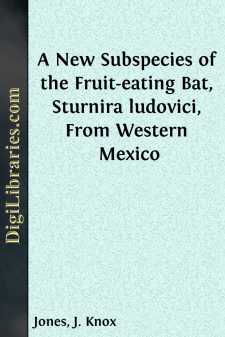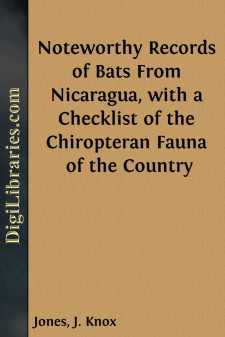Categories
- Antiques & Collectibles 13
- Architecture 36
- Art 48
- Bibles 22
- Biography & Autobiography 813
- Body, Mind & Spirit 141
- Business & Economics 28
- Children's Books 12
- Children's Fiction 9
- Computers 4
- Cooking 94
- Crafts & Hobbies 4
- Drama 346
- Education 46
- Family & Relationships 57
- Fiction 11826
- Games 19
- Gardening 17
- Health & Fitness 34
- History 1377
- House & Home 1
- Humor 147
- Juvenile Fiction 1873
- Juvenile Nonfiction 202
- Language Arts & Disciplines 88
- Law 16
- Literary Collections 686
- Literary Criticism 179
- Mathematics 13
- Medical 41
- Music 40
- Nature 179
- Non-Classifiable 1768
- Performing Arts 7
- Periodicals 1453
- Philosophy 64
- Photography 2
- Poetry 896
- Political Science 203
- Psychology 42
- Reference 154
- Religion 513
- Science 126
- Self-Help 83
- Social Science 81
- Sports & Recreation 34
- Study Aids 3
- Technology & Engineering 59
- Transportation 23
- Travel 463
- True Crime 29
A New Subspecies of the Fruit-eating Bat, Sturnira ludovici, From Western Mexico
by: J. Knox Jones
Description:
Excerpt
The fruit-eating bats of the genus Sturnira are represented on the North American mainland by two species, S. lilium and S. ludovici. The former, in most areas the smaller of the two, is widely distributed in México and Central America and is common in many places. On the other hand, S. ludovici, described by Anthony (1924:8) from near Gualea, Ecuador, generally has been regarded as rare; insofar as we can determine only 20 specimens of the species have been recorded previously from North America (Costa Rica, Honduras, and México).
In 1961 (M. Raymond Lee) and 1962 (Percy L. Clifton), field representatives of the Museum of Natural History collected mammals in western México. Among the bats obtained by them were 23 specimens of S. ludovici, which represent an heretofore undetected subspecies that is named and described below.
Sturnira ludovici occidentalis, new subspecies
Holotype.—Adult female, skin and skull, no. 92798 Museum of Natural History, The University of Kansas, from Plumosas, 2500 feet elevation, Sinaloa; obtained on August 31, 1962, by Percy L. Clifton (original no. 2939).
Distribution.—Western México; known certainly from south-western Durango south to southern Jalisco (see Fig. 1).
Diagnosis.—Size small both externally and cranially (forearm in adults 40.4-44.1 mm., greatest length of skull 21.7-22.9); rostrum short and abruptly elevated; skull relatively broad; dorsal pelage drab brownish over-all, usually lacking epaulets (pale yellowish brown when present); ventral pelage brownish gray.
Comparisons.—From Sturnira ludovici ludovici, the only other subspecies of the species, S. l. occidentalis differs in averaging smaller in most external and cranial dimensions (in some measurements the upper size limits of occidentalis barely overlap the lower limits in specimens of ludovici examined), in having a relatively broader skull with a shorter, more abruptly elevated rostrum, and in being paler both dorsally and ventrally.
From Sturnira lilium parvidens, with which it is sympatric, S. l. occidentalis usually (but not always) differs in being brownish (rather than yellowish to yellowish orange) dorsally and in lacking epaulets, and differs in the following cranial features: first upper incisors simple (rather than weakly bifid in unworn condition), larger, and more nearly straight when viewed from the front; second upper incisors reduced; lower incisors bilobate rather than trilobate; lingual cusps on m1 and m2 greatly reduced; M2 usually turned inward from M1 at distinct angle. The two species have approximately the same external and cranial dimensions in western México.
Measurements (in millimeters).—External measurements of the holotype are as follows: total length, 58; length of hind foot, 15; length of ear, 18; forearm (average of both), 42.5. Corresponding average and extreme measurements of 11 adults from 4 km. N Durazno, Jalisco, followed by those of eight adults from 17 km. SE Talpa, Jalisco, are: 61.9 (59-65), 60.9 (57-68); 14.1 (12-15), 13.0 (13); 16.1 (15-18), 16.0 (15-17); 42.2 (40.4-43.8), 42.9 (41.6-44.1); weight in grams, 16.8 (15-19, six specimens only), 19.2 (16.3-22.5).
Cranial measurements of the holotype additional to those given in Table 1 are: condyloincisive length, 19.7; breadth across upper canines, 5.5; length of mandibular tooth-row (c-m3), 6.7.
Remarks.—The pattern of geographic variation in size in Sturnira ludovici resembles that in many other species of tropical bats in North America in that individuals from the northern parts of the range are smaller than those from the south....










